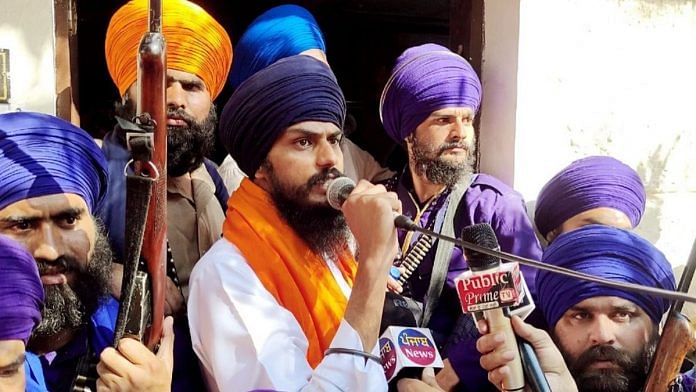The recent episode in Punjab’s Ajnala—where radical activist Amritpal Singh and his supporters stormed a police station and injured six officers—reminds some of the unfortunate events that preceded and instigated Punjab’s submergence in a fathomless quagmire of terrorism in the 1980s. The Punjab imbroglio began in 1978, with a clash between the Sant Nirankari Mission and traditional Sikhs, two religious bodies that eventually pushed Punjab into a decade of violence. This bloody conflict was followed by a long gestation period of about six years before former Prime Minister Indira Gandhi staged ‘Operation Blue Star’ in 1984. To the uninitiated, this military operation was meant to remove Damdami Taksal leader Jarnail Singh Bhindranwale and his followers from the Golden Temple premises in Amritsar. Reportedly “prominent heads of the Khalistan movement”, they sought shelter at the Gurudwara to evade arrest by Indian intelligence agencies.
While the Punjab government has responded more promptly this time, there are lessons to learn from our past.
Before Operation Blue Star, no substantive pre-emptive measures were taken to diffuse Punjab’s smouldering, volatile environment. This lack of foresight had disastrous implications for the state. Total apathy on the part of custodians of law, and the casual approach of political stakeholders in seeking a viable solution to the problem allowed such events to go unchecked. This callousness eventually caused Operation Blue Star, which scarred the collective syncretic psyche of Punjab.
Also read:
Punjab moving toward ‘80s-like violence
Much of the clues behind the rise of terror in Punjab lie in the mercurial corridors of its power politics, which have remained unexplored since before the Army entered the scene in 1984. It seems that the political developments in Punjab are once again being left to themselves, allowing the distinct possibility of their unchecked meandering into an ‘80s-like confrontational paradigm.
The domain of law and order is a delicate issue in the border state of Punjab. It is vulnerable to the machinations of inimical–not necessarily all foreign–forces. If left unattended, its problems can precipitously assume daunting proportions.
Roots of Waris Punjab De
The Amritpal Singh Sidhu-led ‘Waris Punjab De’ gained prominence during the 2020 farm law agitation. It has been in the news since last year, when he took over slain founder Deep Sidhu’s role. Before leading the pro-Khalistan organisation, Amritpal looked after his family’s transport business in Dubai. Since his take over, he has expanded the organisation’s operations to ‘end troubles and long pending issues of the Sikh Panth’.
The Ajnala incident needs to be located within the broader context of various public utterances by Amritpal, and the absence of responses by the state government and other social, political, and religious bodies.
When Amritpal and his supporters stormed a police station to get their associate, Lovepreet Singh ‘Toofan’, released from police custody on 23 February, law enforcement diligently undertook precautionary measures to prevent it from swelling into communal conflict. This action is important, especially when the overdrawn 2015 bargari biadbi (desecration of Sri Guru Granth Sahib) incidents remain under investigation. The current regime’s move is politically correct, and a contrary stance could easily have led to an inflammatory situation with massive deterioration of law and order. If some harm was done to the Palki of Sri Guru Granth Sahib in a hypothetical retaliatory action by the police, it could have led to serious communal implications, given the utmost spiritual status of the sacred scriptures.
Also read: Sikhs no threat to Hindutva but politics has brought back the bogey of Khalistan
Pre-empting violence
Another equally important and often neglected dimension must be boldly underlined: How to pre-empt such a situational matrix and prevent it from arising at all.
There is a dire need to learn and apply lessons from the terrorism that began afflicting Punjab 40 years ago. Events don’t turn unmanageable overnight. A gestation period is a prerequisite for such grievances to arise, fester, strengthen, and become grounded in the consciousness of excitable segments of any population.
Much is expected to be done between these two phases to resolve the crisis, and a win-win perspective is crucial. The Ajnala incident seems to be located within this important framework, where police officers were compelled to take a highly nuanced course of action. This is significant, especially after the state and central governments expressed leniency toward Amritpal after he broke and burned chairs in a Gurudwara last year, to the point where they were accused of complicity for political gains.
Ronki Ram is Shaheed Bhagat Singh Chair Professor of Political Science, Panjab University, Chandigarh. Views are personal.
(Edited by Zoya Bhatti)



